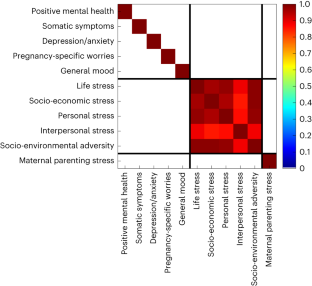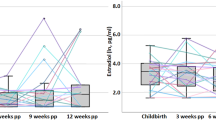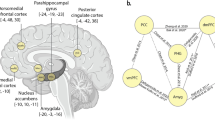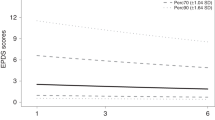Abstract
Positive mental health is an essential component of overall health and well-being. However, research in this area has been relatively neglected. This study used a longitudinal dataset to investigate the impact of maternal positive emotions during pregnancy on brain structure and function in 7.5-year-old children (n = 381). A positive maternal mental health measure, including positive affect and emotional well-being during pregnancy, was developed through confirmatory factor analysis of questionnaires administered at 26–28 weeks. The study found that girls born to mothers who reported greater positive mental health during pregnancy showed larger bilateral hippocampi. Furthermore, children of mothers with greater positive mental health exhibited altered functional connectivity of several networks, including default mode, salience, executive control, amygdala and thalamo-hippocampal networks. These findings extend the study of maternal mental health beyond maternal psychopathology, suggesting the importance of promoting positive maternal mental health during pregnancy as a potential protective factor for offspring brain development.
This is a preview of subscription content, access via your institution
Access options
Subscribe to this journal
Receive 12 digital issues and online access to articles
$59.00 per year
only $4.92 per issue
Buy this article
- Purchase on Springer Link
- Instant access to full article PDF
Prices may be subject to local taxes which are calculated during checkout



Similar content being viewed by others
Data availability
The datasets used in the current study are available. However, external investigators who plan to use data from the GUSTO study should fill out a request form (https://fas.sicsapps.com/site/login) and describe the study proposal.
Code availability
All results were obtained via the fitlm function in MATLAB and SurfStat available at https://www.math.mcgill.ca/keith/surfstat/.
References
Buss, C. et al. Maternal cortisol over the course of pregnancy and subsequent child amygdala and hippocampus volumes and affective problems. Proc. Natl Acad. Sci. USA 109, E1312–E1319 (2012).
Buss, C., Davis, E. P., Muftuler, L. T., Head, K. & Sandman, C. A. High pregnancy anxiety during mid-gestation is associated with decreased gray matter density in 6–9-year-old children. Psychoneuroendocrinology 35, 141–153 (2010).
Qiu, A. et al. Prenatal maternal depression alters amygdala functional connectivity in 6-month-old infants. Transl. Psychiatry 5, e508 (2015).
Qiu, A. et al. Maternal anxiety and infants’ hippocampal development: timing matters. Transl. Psychiatry 3, e306 (2013).
Qiu, A. et al. Effects of antenatal maternal depressive symptoms and socio-economic status on neonatal brain development are modulated by genetic risk. Cereb. Cortex 27, 3080–3092 (2017).
Wei, D. et al. Cortical development mediates association of prenatal maternal depressive symptoms and child reward sensitivity: a longitudinal study. J. Am. Acad. Child Adolesc. Psychiatry 61, 392–401 (2022).
Zhang, H. et al. Maternal adverse childhood experience and depression in relation with brain network development and behaviors in children: a longitudinal study. Cereb. Cortex 31, 4233–4244 (2021).
Graham, R. M. et al. Maternal anxiety and depression during late pregnancy and newborn brain white matter development. Am. J. Neuroradiol. 41, 1908–1915 (2020).
Jha, S. C. et al. Antenatal depression, treatment with selective serotonin reuptake inhibitors, and neonatal brain structure: a propensity-matched cohort study. Psychiatry Res. Neuroimaging 253, 43–53 (2016).
Wen, D. J. et al. Influences of prenatal and postnatal maternal depression on amygdala volume and microstructure in young children. Transl. Psychiatry 7, e1103 (2017).
Sandman, C. A., Buss, C., Head, K. & Davis, E. P. Fetal exposure to maternal depressive symptoms is associated with cortical thickness in late childhood. Biol. Psychiatry 77, 324–334 (2015).
Soe, N. N. et al. Perinatal maternal depressive symptoms alter amygdala functional connectivity in girls. Hum. Brain Mapp. 39, 680–690 (2018).
Rifkin-Graboi, A. et al. Prenatal maternal depression associates with microstructure of right amygdala in neonates at birth. Biol. Psychiatry 74, 837–844 (2013).
Meaney, M. J. Perinatal maternal depressive symptoms as an issue for population health. Am. J. Psychiatry 175, 1084–1093 (2018).
Phua, D. Y. et al. Positive maternal mental health during pregnancy associated with specific forms of adaptive development in early childhood: evidence from a longitudinal study. Dev. Psychopathol. 29, 1573–1587 (2017).
Lamers, S. M., Westerhof, G. J., Glas, C. A. & Bohlmeijer, E. T. The bidirectional relation between positive mental health and psychopathology in a longitudinal representative panel study. J. Posit. Psychol. 10, 553–560 (2015).
Keyes, C. L., Dhingra, S. S. & Simoes, E. J. Change in level of positive mental health as a predictor of future risk of mental illness. Am. J. Public Health 100, 2366–2371 (2010).
Rifkin-Graboi, A. et al. Maternal sensitivity, infant limbic structure volume and functional connectivity: a preliminary study. Transl. Psychiatry 5, e668 (2015).
Lee, A. et al. Maternal care in infancy and the course of limbic development. Dev. Cogn. Neurosci. 40, 100714 (2019).
Rifkin-Graboi, A. et al. An initial investigation of neonatal neuroanatomy, caregiving, and levels of disorganized behavior. Proc. Natl Acad. Sci. USA 116, 16787–16792 (2019).
Meades, R. & Ayers, S. Anxiety measures validated in perinatal populations: a systematic review. J. Affect. Disord. 133, 1–15 (2011).
Beck, A. T., Ward, C. H., Mendelson, M., Mock, J. & Erbaugh, J. An inventory for measuring depression. Arch. Gen. Psychiatry 4, 561–571 (1961).
Cox, J. L., Holden, J. M. & Sagovsky, R. Detection of postnatal depression. Development of the 10-item Edinburgh Postnatal Depression Scale. Br. J. Psychiatry 150, 782–786 (1987).
Reichenheim, M. E., Moraes, C. L., Oliveira, A. S. & Lobato, G. Revisiting the dimensional structure of the Edinburgh Postnatal Depression Scale (EPDS): empirical evidence for a general factor. BMC Med. Res. Methodol. 11, 93 (2011).
Szekely, E. et al. Maternal prenatal mood, pregnancy-specific worries, and early child psychopathology: findings from the DREAM BIG Consortium. J. Am. Acad. Child Adolesc. Psychiatry 60, 186–197 (2021).
O’Donnell, K. A. et al. The Maternal Adversity, Vulnerability and Neurodevelopment Project: theory and methodology. Can. J. Psychiatry 59, 497–508 (2014).
Rosseel, Y. lavaan: an R package for structural equation modeling. J. Stat. Softw. 48, 1–36 (2012).
Unternaehrer, E. et al. Dissecting maternal care: patterns of maternal parenting in a prospective cohort study. J. Neuroendocrinol. 31, e12784 (2019).
Li, J. et al. Late gestational maternal serum cortisol is inversely associated with fetal brain growth. Neurosci. Biobehav. Rev. 36, 1085–1092 (2012).
Vreeburg, S. A. et al. Salivary cortisol levels in persons with and without different anxiety disorders. Psychosom. Med. 72, 340–347 (2010).
Coe, C. L. et al. Prenatal stress diminishes neurogenesis in the dentate gyrus of juvenile rhesus monkeys. Biol. Psychiatry 54, 1025–1034 (2003).
Weinstock, M. The long-term behavioural consequences of prenatal stress. Neurosci. Biobehav. Rev. 32, 1073–1086 (2008).
Leerkes, E. M. et al. Antecedents of maternal sensitivity during distressing tasks: integrating attachment, social information processing, and psychobiological perspectives. Child Dev. 86, 94–111 (2015).
Vieten, C. et al. The mindful moms training: development of a mindfulness-based intervention to reduce stress and overeating during pregnancy. BMC Pregnancy Childbirth 18, 201 (2018).
Assel, M. A. et al. How do mothers’ childrearing histories, stress and parenting affect children’s behavioural outcomes? Child Care Health Dev. 28, 359–368 (2002).
Luby, J. L. et al. Maternal support in early childhood predicts larger hippocampal volumes at school age. Proc. Natl Acad. Sci. USA 109, 2854–2859 (2012).
Wang, Q. et al. Maternal sensitivity predicts anterior hippocampal functional networks in early childhood. Brain Struct. Funct. 224, 1885–1895 (2019).
Barch, D. M. et al. Hippocampal volume and depression among young children. Psychiatry Res. Neuroimaging 288, 21–28 (2019).
Barch, D. M., Harms, M. P., Tillman, R., Hawkey, E. & Luby, J. L. Early childhood depression, emotion regulation, episodic memory, and hippocampal development. J. Abnorm. Psychol. 128, 81–95 (2019).
Barch, D. M., Gaffrey, M. S., Botteron, K. N., Belden, A. C. & Luby, J. L. Functional brain activation to emotionally valenced faces in school-aged children with a history of preschool-onset major depression. Biol. Psychiatry 72, 1035–1042 (2012).
Gaffrey, M. S., Luby, J. L., Botteron, K., Repovs, G. & Barch, D. M. Default mode network connectivity in children with a history of preschool onset depression. J. Child Psychol. Psychiatry 53, 964–972 (2012).
Perino, M. T. et al. Attention alterations in pediatric anxiety: evidence from behavior and neuroimaging. Biol. Psychiatry 89, 726–734 (2021).
Sylvester, C. M. et al. Resting state functional connectivity of the ventral attention network in children with a history of depression or anxiety. J. Am. Acad. Child Adolesc. Psychiatry 52, 1326–1336.e5 (2013).
Ryff, C. D. & Singer, B. H. Best news yet on the six-factor model of well-being. Soc. Sci. Res. 35, 1103–1119 (2006).
Soh, S. E. et al. The methodology of the GUSTO cohort study: a novel approach in studying pediatric allergy. Asia Pac. Allergy 2, 144–148 (2012).
Du, J., Younes, L. & Qiu, A. Whole brain diffeomorphic metric mapping via integration of sulcal and gyral curves, cortical surfaces, and images. NeuroImage 56, 162–173 (2011).
Tan, M. & Qiu, A. Large deformation multiresolution diffeomorphic metric mapping for multiresolution cortical surfaces: a coarse-to-fine approach. IEEE Trans. Image Process. 25, 4061–4074 (2016).
Power, J. D., Barnes, K. A., Snyder, A. Z., Schlaggar, B. L. & Petersen, S. E. Spurious but systematic correlations in functional connectivity MRI networks arise from subject motion. NeuroImage 59, 2142–2154 (2012).
Alcauter, S. et al. Development of thalamocortical connectivity during infancy and its cognitive correlations. J. Neurosci. 34, 9067–9075 (2014).
Power, J. D. et al. Methods to detect, characterize, and remove motion artifact in resting state fMRI. NeuroImage 84, 320–341 (2014).
Shen, X. et al. Using connectome-based predictive modeling to predict individual behavior from brain connectivity. Nat. Protoc. 12, 506–518 (2017).
Casey, B. J. et al. The Adolescent Brain Cognitive Development (ABCD) study: imaging acquisition across 21 sites. Dev. Cogn. Neurosci. 32, 43–54 (2018).
Cecil, C. A. et al. Environmental risk, Oxytocin Receptor Gene (OXTR) methylation and youth callous–unemotional traits: a 13-year longitudinal study. Mol. Psychiatry 19, 1071–1077 (2014).
Rijlaarsdam, J. et al. An epigenome-wide association meta-analysis of prenatal maternal stress in neonates: a model approach for replication. Epigenetics 11, 140–149 (2016).
Acknowledgements
This research is supported by STI 2030—Major Projects (No. 2022ZD0209000) (A.Q.) and the Singapore National Research Foundation under its Translational and Clinical Research (TCR) Flagship Programme and administered by the Singapore Ministry of Health’s National Medical Research Council (NMRC), Singapore- NMRC/TCR/004-NUS/2008 (A.Q., Y.-S.C.), NMRC/TCR/012-NUHS/2014 (A.Q., Y.-S.C.). Additional funding is provided by the National Research Foundation, Singapore, and the Agency for Science Technology and Research (A*STAR), Singapore, under its Prenatal/Early Childhood Grant (grant H22P0M0007) (A.Q.), the Canadian Institutes of Health Research (359912, 365309 and 231614) (A.W.) and the Fonds de la recherche en santé du Québec (FRSQ; grant 22418) (A.W.).
Author information
Authors and Affiliations
Contributions
The study was conceived by A.Q. All authors had full access to all the data in the study and had final responsibility for the decision to submit for publication. A.Q. and C.S. contributed to brain image analysis and statistical analysis. M.L.-V. and E.S. contributed to CFA. A.Q. and Y.-S.C. contributed to the fund acquisition for the GUSTO data collection. A.Q., T.W. and A.W. contributed to the initial manuscript writing and revision and interpretation of data.
Corresponding author
Ethics declarations
Competing interests
The authors declare no competing interests.
Peer review
Peer review information
Nature Mental Health thanks Saara Nolvi, Androniki Raftogianni and the other, anonymous, reviewer(s) for their contribution to the peer review of this work.
Additional information
Publisher’s note Springer Nature remains neutral with regard to jurisdictional claims in published maps and institutional affiliations.
Supplementary information
Supplementary Information
Supplementary Figs. 1 and 2, Tables 1–8 and Discussion.
Rights and permissions
Springer Nature or its licensor (e.g. a society or other partner) holds exclusive rights to this article under a publishing agreement with the author(s) or other rightsholder(s); author self-archiving of the accepted manuscript version of this article is solely governed by the terms of such publishing agreement and applicable law.
About this article
Cite this article
Qiu, A., Shen, C., López-Vicente, M. et al. Maternal positive mental health during pregnancy impacts the hippocampus and functional brain networks in children. Nat. Mental Health 2, 320–327 (2024). https://doi.org/10.1038/s44220-024-00202-8
Received:
Accepted:
Published:
Issue Date:
DOI: https://doi.org/10.1038/s44220-024-00202-8



